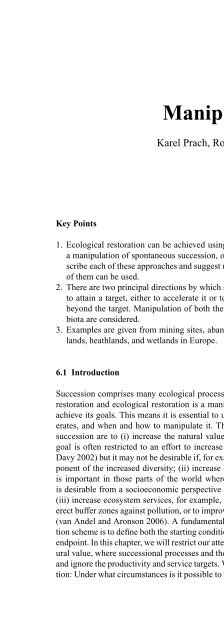Linking Restoration and Ecological Succession (Springer ... - Inecol
Linking Restoration and Ecological Succession (Springer ... - Inecol
Linking Restoration and Ecological Succession (Springer ... - Inecol
You also want an ePaper? Increase the reach of your titles
YUMPU automatically turns print PDFs into web optimized ePapers that Google loves.
Key Points<br />
6<br />
Manipulation of <strong>Succession</strong><br />
Karel Prach, Rob Marrs, Petr Pyˇsek, <strong>and</strong> Rudy van Diggelen<br />
1. <strong>Ecological</strong> restoration can be achieved using either unassisted succession,<br />
a manipulation of spontaneous succession, or technical restoration. We describe<br />
each of these approaches <strong>and</strong> suggest under what circumstances each<br />
of them can be used.<br />
2. There are two principal directions by which succession can be manipulated<br />
to attain a target, either to accelerate it or to reverse it if it has proceeded<br />
beyond the target. Manipulation of both the physical environment <strong>and</strong> the<br />
biota are considered.<br />
3. Examples are given from mining sites, ab<strong>and</strong>oned fields, secondary grassl<strong>and</strong>s,<br />
heathl<strong>and</strong>s, <strong>and</strong> wetl<strong>and</strong>s in Europe.<br />
6.1 Introduction<br />
<strong>Succession</strong> comprises many ecological processes that underpin all ecological<br />
restoration <strong>and</strong> ecological restoration is a manipulation of these processes to<br />
achieve its goals. This means it is essential to underst<strong>and</strong> how succession operates,<br />
<strong>and</strong> when <strong>and</strong> how to manipulate it. The main goals of manipulating<br />
succession are to (i) increase the natural value of degraded ecosystems; this<br />
goal is often restricted to an effort to increase species diversity (Perrow <strong>and</strong><br />
Davy 2002) but it may not be desirable if, for example, alien species are a component<br />
of the increased diversity; (ii) increase ecosystem productivity, which<br />
is important in those parts of the world where any increase in productivity<br />
is desirable from a socioeconomic perspective (Wali 1992, Whisenant 1999);<br />
(iii) increase ecosystem services, for example, to protect against soil erosion,<br />
erect buffer zones against pollution, or to improve the aesthetic quality of a site<br />
(van Andel <strong>and</strong> Aronson 2006). A fundamental starting point for any restoration<br />
scheme is to define both the starting conditions <strong>and</strong> the target ecosystem or<br />
endpoint. In this chapter, we will restrict our attention to targets with a high natural<br />
value, where successional processes <strong>and</strong> their manipulation are important,<br />
<strong>and</strong> ignore the productivity <strong>and</strong> service targets. We attempt to address the question:<br />
Under what circumstances is it possible to rely on unassisted spontaneous<br />
121

















